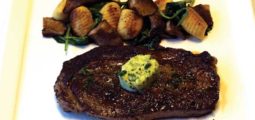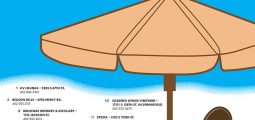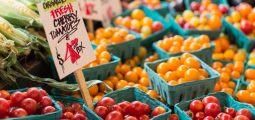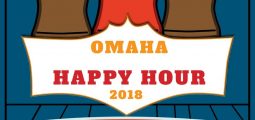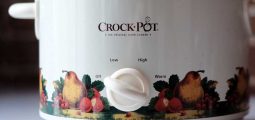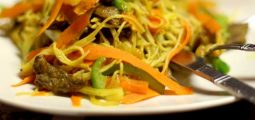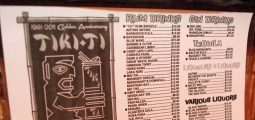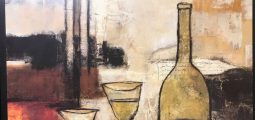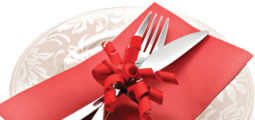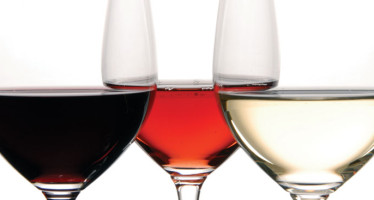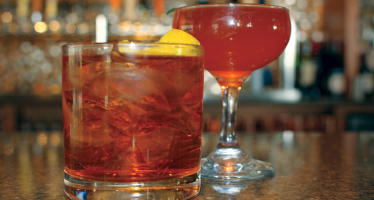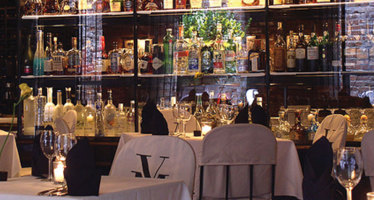Bubbly 101
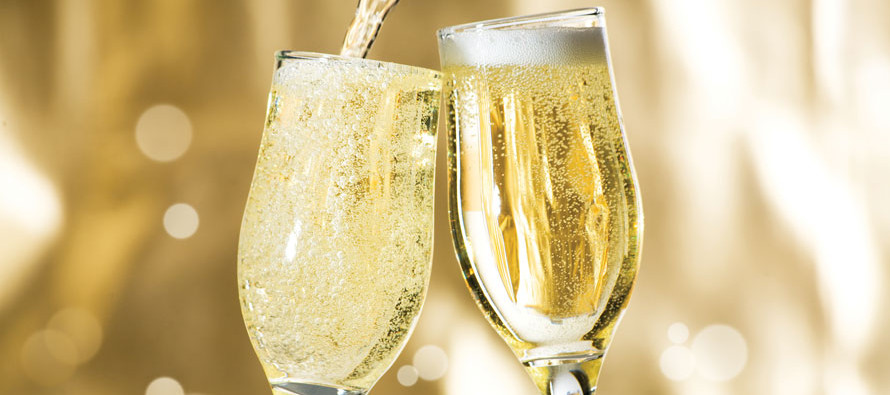
Having the holidays almost upon us signals the coming of many traditions. From the onset of a hard Nebraska winter to various religious observations, and from a zealous embrace of all things capitalistic to the popping of countless corks across the globe as the advent of 2016 is celebrated with toast after toast of sparkling wine. What will be held high in those glasses varies almost as widely as the people holding them, and most of it isn’t “champagne,” but sparkling wine.
What is sparkling wine and how do you know which one is right for ringing in the New Year your way? As we prepare to transition into 2016, knowing something about what comes between the pop and the headache may help enhance the overall experience.
Sparkling wine can be, and is, made virtually everywhere. From the famous Champagne region of France to right here locally, where both James Arthur Vineyards (just north of Lincoln) as well as Soaring Wings (just outside of Omaha) are bottling their bubbly for consumption here in Nebraska. Traditionally, sparkling wine was made using a secondary fermentation to create the fizz, though today that which is not made in the “methode champenoise” is often simply injected with gas.
Regardless of how it gets that way, fizzy wine wasn’t always so popular; the infamous eponym Dom Perignon, a French monk who no doubt unwillingly lent his name to the French Champagne house of Moet and Chandon post mortem, would have, like the rest of his fellow Champenoise at that time, consumed almost entirely red wine and would have cringed at wine with bubbles in it. The famous monk was indeed a vintner – and a good one – yet one of his most ambitious pursuits was never realized: his effort to find a way to remove the hated bubbles from his wine, especially in the spring when live yeast strands began predictably to awaken. In other words, the ritzy, rapped-about stuff we pay as much as $200 per bottle for would most likely have been dumped in the gutter by its own namesake. I suppose if you run out of aged Gouda, you could always pair your Dom with a generous side of irony.
Just because it wasn’t en vogue to drink sparkling wine in the late seventeenth century doesn’t mean the stuff isn’t mighty tasty today, and one can’t deny the tiny rush you get from popping the cork on a bottle of champagne. Champagne, of course, is a region in France, east of Paris, and bordering Germany. For wine to truly be “Champagne” it must come from that region; famous examples include the aforementioned Dom, as well as Veuve Cliquot and countless others.
When it first became “a thing,” sparkling Champagne tended to explode in the bottles, or else blow the corks, with some estimates ranging as high as 90% of the product being destroyed prior to delivery, which may help explain the high cost (at least back then). Today, however, both Champagne proper and champagne as erroneous slang for all wines sparkling are readily available from all over the world, in a variety of styles, costs and more. Clearly, there’s a lot to know. The following, divided into tips for consumption, vocabulary and types of sparkling wine, will hopefully assist you in ringing in 2016 on a foaming high note.
Tips and Etiquette for Drinking Sparkling Wine
- You’re not in the fraternity anymore and you didn’t just win the Daytona 500, so don’t shake the stupid bottle before you pop the cork. Yes, if you do, you will create a pseudo-sexual explosion that your eighteen-year-old self would have thought was hilarious, but if you’re old enough to buy alcohol, you should be well past the age to know better than to spray people with wine in public. In fact, the less pomp and circumstance that goes into removing the cork, the better it holds its form. Try wrapping a towel around the cork and slowly twisting the bottle and cork in opposite directions. Far less Hollywood, but far more appropriate for a casual New Years gathering.
- Always serve it chilled. That’s all. But it’s a rule so be sure you do it. Nobody wants warm bubbly. Seriously. Buy some ice.
- When it comes to storage, sparkling wine can be tricky. While most wine doesn’t do well in heat or pressure, this is especially true of sparkling wine, so take good care of it. Also, unlike most wines, sparkling wine corks can’t be stuffed back into the neck of the bottle (or worse, screwed back on), so if you go to bed before you kill the bottle, try sticking a silver spoon, handle-first, in the bottle neck to help preserve the carbonation until it’s time to make mimosas. (I have no idea why it works but it truly seems to.)
- Pour slowly. It’s carbonated, remember? If you dump it at even the same rate you might fill a different type of wine, you’ll wind up covering your friends’ hands in sticky liquid.
- Imbibe responsibly. Yes, it’s totally cliché to say that, but sparkling wine drinks like Diet Sprite, and it’s far too easy to consume far too much of it. And while it’s a great idea to celebrate the New Year, you don’t want your first memories of 2016 to be shared with Bob the Truck Stop Fugitive in a jail cell… or do you?
Vocabulary
If you find yourself the one shopping for sparkling wine this holiday season, there are a few key terms you probably ought to know, from different sizes or “formats” to a handful of common expressions. The following may help (or may just confuse the hell out of you).
Balthazar: A 12-liter bottle, see also: 16 bottles of champagne in one. Also the name of the guy who tells Romeo that Juliet is dead, even thought she isn’t, inspiring him to commit suicide in front of her undead corpse out of grief. Jerk.
Blanc de Blancs: Sparkling wine made entirely of white grapes, almost assuredly chardonnay.
Blanc de Noirs: Sparkling wine made entirely of red grapes, most likely Pinot Noir, Pinot Meunier, or a blend of the two. Note: It still appears very light in color, because it spends almost no time on the skins to give it pigment.
Brut: Sparkling wine with very little or no sugar added. See also: knuckle-dragger.
Capsule: The twisty wire thingy with a cap that holds the cork in. Large, overpriced beers often have these too.
Champagne: A wine region in France, and also the wine made in that region. Not a legitimate synonym for fizzy wine.
Corked: The stank of soggy cardboard, which carries from the nose over to the palate, and indicates that the contents of a bottle are defunct. Unless purchased from criminals, this wine should be returnable (provided you didn’t drink nine-tenths of it first).
Jeroboam: Four bottles – or two magnums – of wine. Also the name of the King of Israel from 922 to 901 BC, which is fun party trivia only if people have already had four bottles of bubbly.
Magnum: Two bottles of wine, or 1.5 liters.
Methode Champenois: The method of the people who live in Champagne. That is, the traditional method of making this stuff.
Methuselah: A huge bottle, holding eight bottles of wine, or four magnums. According to the book of Genesis, he lived to be 969 years old, most likely the product of a strong heart brought about by drinking a glass of red wine nightly.
Nabuchadnezzar: Twenty bottles of wine, ten Magnums, five Jeroboams, two and a half Methuselahs, and a partridge in a pear tree. Note: do not get hit in the face with this cork.
Sec: Technically, this means dry, but with sparkling wine it actually means less-dry (has more sugar) than brut. It’s sort of like when you ask if you can do something and your significant others says that’s “fine.” You both know that isn’t fine. So it is with sec. We both know that isn’t dry.
Sexual Confusion: Kind of low-hanging fruit, granted, but a wine term all the same. In fact, sexual confusion actually has even more to do with wine than you probably think. Technically speaking, it’s the process of distributing pheromones amongst grape vines to confuse male grape moths and keep them from breeding. It’s an alternative to nasty chemicals. So just in case you thought you were the only one whose ability to breed was being negatively impacted by the wine industry, think again.
Split: Half of a half of a bottle of wine, and or 1/80th of a Nabuchadnessar. See also: a gulp.
Types of Sparkling Wine
The next thing you ought to know is that you are in no way limited to true Champagne (unless your father in law expects it, at which point, don’t skimp). There are tons of great wines available that, while not from Champagne or even France, will work well to bring in the New Year or to toast that special someone. Here are some examples.
Cremant (pronounced cray-mon) is a fun take on sparkling wine, typically though not exclusively produced in France and hailing from outside the Champagne region. The name once indicated less fizz and a more creamy texture, but today that isn’t always the case. It’s also often made from grapes other than the rigid few varietals (Chardonnay, Pinot Noir, and Pinot Meunier) found in true Champagne.
Prosecco is an Italian take on sparkling wine that is often served as an aperitif. Originally from the Veneto region, Prosecco isn’t typically made in the traditional “methode champenois,” making it significantly cheaper to produce and thus, to purchase. Dollar for dollar, it’s often a pretty solid buy when it comes to bubbly… if you can get past the fact that these guys switched sides between the First and Second World War. I mean, who does that?
The Germans call their bubbly Sekt, and while it’s often very dry and quite enjoyable, most Germans seem to prefer Champagne (and owning French Champagne houses), making the export of Sekt a rather niche industry. Nevertheless, there are some great Sekts out there if you can find them, perfect for pairing with a nice Christmas kielbasa.
The Spanish, too, have fizzy wines, and theirs is typically deemed Cava. Cava ranges from dry to sweet, comes in white or rose, most often utilizes the usual labels (brut, sec, and so forth) and comes in the standard formats. Most of it comes from Catalonia, a region of Spain that is currently attempting to secede, which would make it the 197th (and single poorest) country in the world.
Finally, we here in America produce our own variation of sparkling wines. Some, like Chandon (yes, that Chandon) are infamous, while others like Peju, are virtually unknown. Both are excellent. Schramsberg is one of the oldest producers of sparkling wine in the United States and their wines can be found easily at a variety of Omaha locations. No wine made in the United States is true Champagne, but it doesn’t have to be Champagne to be wonderful. The stuff that didn’t suffer a long ocean journey is often better off for it. Plus, you know, #drinklocal and all that.
Whatever cork you ultimately decide to pop this holiday season, and wherever you decide to pop it, being conscious of its source, and of the history and traditions of that place, is a great way to enjoy it. You don’t have to be a snob to know what kind of wine you’re drinking, to know your Prosecco from Champagne and simple toasts are relatively easy to learn in almost any language. As airplanes and the internet increasingly shrink the size of our planet and the distance between us all, ringing in the New Year can become a means of embracing the cultures that bring us, amongst so many contributions, wonderful carbonated wine. So Happy New Year! Ein glückliches neues jahr! Feliz año nuevo! Bonne Annee! Shana tova! And most of all, cheers!

Mark Gudgel
Dr. Mark Gudgel is a wine writer and educator who holds credentials through the Wine & Spirit Education Trust (WSET) and is working towards becoming a Master of Wine. His interest in wine was sparked on his honeymoon to Napa and Sonoma. Gudgel and his wife, Sonja, have co-authored several articles as well as a book on the wineries of Nebraska, to be released in the spring of 2017. Gudgel is a regular contributor to Food & Spirits Magazine and American Winery Guide, as well as the blog he maintains with his wife, www.itheewine.com. Mark and Sonja live in Omaha with their children and their dog.
Related Articles
A Color-Code for the History of Wine
I’m sure that somebody somewhere has written a comprehensive book on the history of wine. Surely it must be one
Spring in a Glass: The Flavors of Omaha’s Cocktail Scene
Along with craft beer and homemade soda, handmade cocktails are making a comeback. Shaken with local bitters and stirred with
The State of the Cocktail: V Mertz and the Artful Pairing of Food & Spirits
In my continuing quest to evaluate the state of the cocktail art here in Nebraska, I have discovered some applications
No comments
Write a commentOnly registered users can comment.


